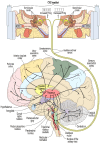Vestibular Neurostimulation for Parkinson's Disease: A Novel Device-Aided Non-Invasive Therapeutic Option
- PMID: 39338187
- PMCID: PMC11432959
- DOI: 10.3390/jpm14090933
Vestibular Neurostimulation for Parkinson's Disease: A Novel Device-Aided Non-Invasive Therapeutic Option
Abstract
Dopaminergic replacement therapy remains the mainstay of symptomatic treatment for Parkinson's disease (PD), but many unmet needs and gaps remain. Device-based treatments or device-aided non-oral therapies are typically used in the advanced stages of PD, ranging from stereotactic deep brain stimulation to levodopa or apomorphine infusion therapies. But there are concerns associated with these late-stage therapies due to a number of procedural, hardware, or long-term treatment-related side effects of these treatments, and their limited nonmotor benefit in PD. Therefore, there is an urgent unmet need for low-risk adjuvants or standalone therapies which can address the range of burdensome motor and nonmotor symptoms that occur in PD. Recent studies suggest that non-invasive neurostimulation of the vestibular system may be able to address these gaps through the stimulation of the vestibular brainstem sensory network which extensively innervates brain regions, regulating both motor and a range of nonmotor functions. Therapeutic non-invasive vestibular stimulation is a relatively modern concept that may potentially improve a broad range of motor and nonmotor symptoms of PD, even at early stages of the disease. Here, we review previous studies supporting the therapeutic potential of vestibular stimulation for the treatment of PD and discuss ongoing clinical trials and potential areas for future investigations.
Keywords: Parkinson’s disease; caloric vestibular stimulation; galvanic vestibular stimulation; non-invasive neuromodulation; sensory neuromodulation; vestibular system.
Conflict of interest statement
K.A. is employed by Scion NeuroStim, Inc., manufacturer of the time-varying caloric vestibular stimulation device mentioned in the paper. The rest of the authors declare that they have no known competing financial interests or personal relationships that could have appeared to influence the work reported in this paper.
Figures


References
-
- Chaudhuri K.R., Prieto-Jurcynska C., Naidu Y., Mitra T., Frades-Payo B., Tluk S. The nondeclaration of nonmotor symptoms of Parkinson’s disease to health care professionals: An international study using the nonmotor symptoms questionnaire. Mov. Disord. 2010;25:704–709. doi: 10.1002/mds.22868. - DOI - PubMed
-
- Williams D., Tijssen M., Van Bruggen G., Bosch A., Insola A., Lazzaro V.D., Mazzone P., Oliviero A., Quartarone A., Speelman H., et al. Dopamine dependent changes in the functional connectivity between basal ganglia and cerebral cortex in humans. Brain. 2002;125:1558–1569. doi: 10.1093/brain/awf156. - DOI - PubMed
Publication types
LinkOut - more resources
Full Text Sources

